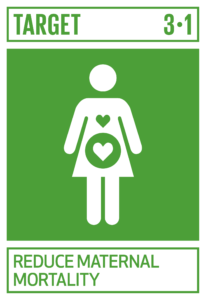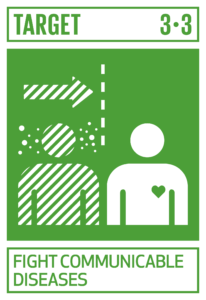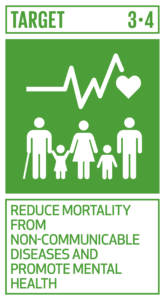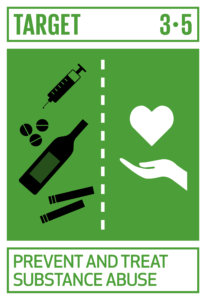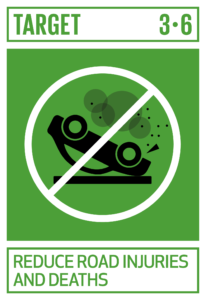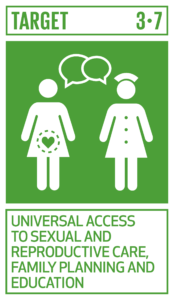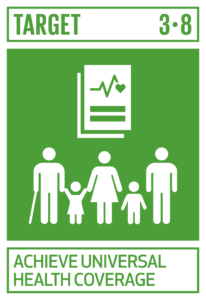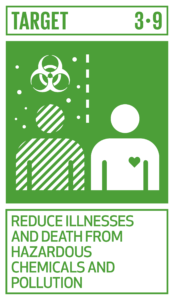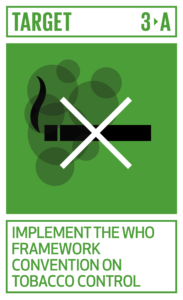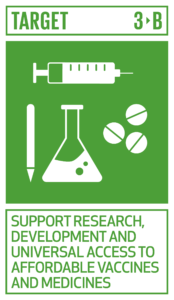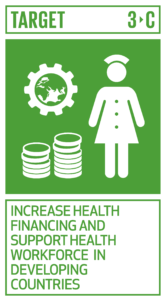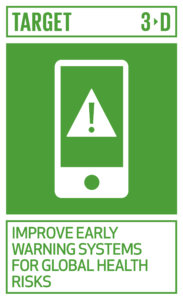Sustainable Development Goal 3, “Ensure healthy lives and promote well-being for all at all ages”, consists of 13 targets with 26 indicators. The targets include maternal health (3.1) and child health (3.2), communicable (3.3) and non-communicable (3.4) diseases, substance abuse (3.5), road traffic accidents (3.6), sexual and reproductive health care (3.7), universal health coverage (3.8) and environmental hazards (3.9). Furthermore, tobacco control (3.a), research and development for vaccines and medicines (3.b), health financing & health workforce (3.c) as well as international health regulations (3.d) are included in SDG3. Around 50 other SDG targets are interlinked with SDG3, which underlines its relevance.1
Transition from the MDGs to the SDGs
The SDGs build on the Millennium Development Goals. The eight MDG targets included three focused on health.[ref]UNDP. Background on the Goals. Accessed November 7, 2019.[/ref] Even though many countries, including Myanmar, experienced great improvements in overall health during the MDG era, challenges remain and need to be further addressed to reach SDG 3 by 2030.2 For instance, by 2015, the targets for MDG 4 (child and infant mortality) and MDG 5 (maternal mortality) had not been achieved in Myanmar. Progress on MDG 6: Combat HIV/AIDS, malaria and other diseases, was mixed, as Myanmar greatly reduced incidences of malaria, but not tuberculosis.
The localization of SDG 3 in Myanmar
Despite improvements, the health of the people of Myanmar remains poor as compared to other ASEAN countries.3 In addition, a rural-urban divide exists in accessing health services. Travel time, language barriers, and time restrictions force people to choose more expensive private providers.4 Ethnic minorities also have difficulty accessing health services, and the services they have are often of lower quality.5 Furthermore, social norms such as traditional birth practices, negative views on contraceptives and power differences between men and women impact women’s access.6
Thus, Myanmar has recognized all SDG 3 indicators as relevant to the country. Baseline data, collected by the Central Statistics Organization (CSO) with the assistance of UNDP7, was available for 20 of the 26 SDG 3 targets in 2017. Data for the remaining 6 indicators (3.3.3, 3.3.4, 3.5.1, 3.8.1, 3.b.1, 3.b.3) was either missing or unreliable. Reliability is complicated because baseline data is sourced from both national and international data producers and it is not always completely transparent if data meets quality standards. The UN Inter-Agency and Expert Group on SDGs established guidelines on data sources, which suggests that national sources be used before international ones. To support this, national statistical capacity needs to be improved, and a single institution needs to take responsibility for final data compilation, like the CSO does in Myanmar.8 The Government of Myanmar stresses the importance of national and international collaborations9, especially to enhance statistical capacity.
The Ministry of Health and Sports has established a number of relevant policies. The most recent National Health Plan 2017-2021 focuses on universal health care. Several strategic plans cover assistance to target populations such as school children, or management of specific diseases, such as non-communicable diseases, HIV/AIDS, and tuberculosis.10 Because maternal mortality, child and infant death rates, prevalence of HIV, and rates of NCDs are of particular concern to the Ministry of Health and Sports, this page focuses on these issues.
Maternal Mortality (SDG 3.1)
Maternal mortality rates are worryingly high in Myanmar, despite the implementation of strategies to enhance reproductive health. The 2017 maternal mortality ratio (MMRatio) was 250/100,000 live births, which represents only a small decrease from 282 per 100,000 live births in 2014, which was then double the Southeast Asian regional average (140/100,000 live births in 2014).11 Reliable data on Myanmar’s maternal mortality was practically nonexistent until 2014, when this data was collected in the census.
Rapid progress will be necessary to meet SDG 3.1, which aims for a MMRatio of 70/100,000 live births. Other LMCs, such as Cambodia and Lao PDR, have shown positive results in reducing MMRatio. Their strategies might be applicable to Myanmar. Empowering women is another key aspect of preventing maternal mortality. This can be achieved by making reproductive health care available for everyone12
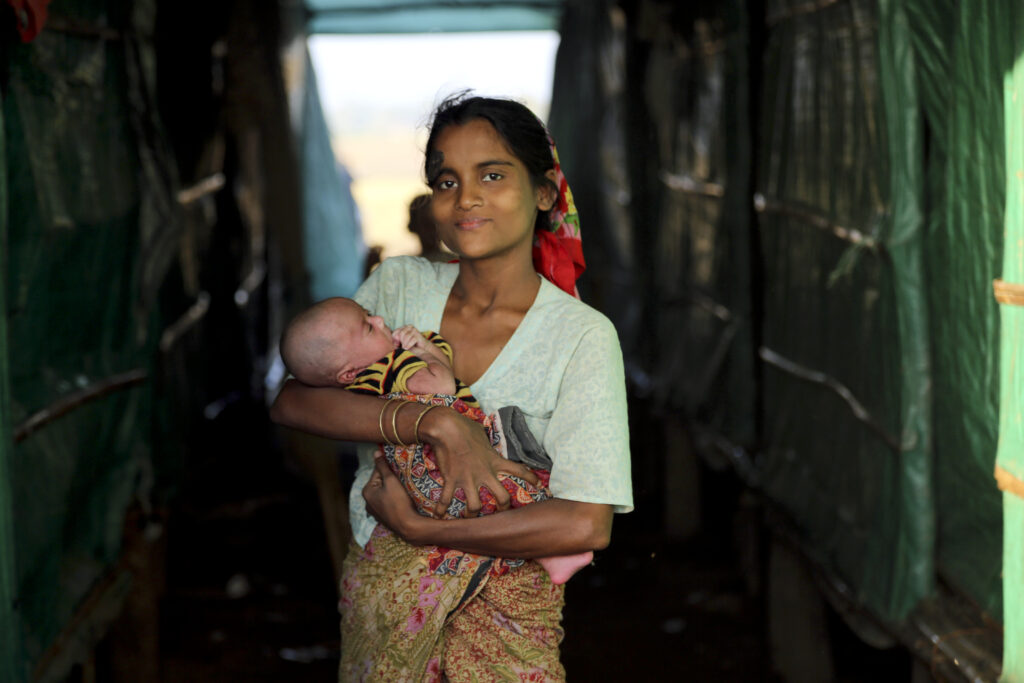
Mother and child in a displacement camp in Myanmar. Photo by UN Photo/David Ohana via Flickr. Licensed under CC BY-NC-ND 2.0.
Neonatal and children <5 mortality
In the last decades, Myanmar experienced an estimated 60% reduction in the under-five mortality rate, from 115 deaths per 1,000 live births in 1990 to 46 deaths per 1,000 live births in 2018.13 Similar results were achieved for infant mortality rate, with an estimated reduction of over 50% from 82 to 37 deaths per 1,000 live births between 1990-2018.14 This considerable achievement requires a further reduction to reach SDG 3.2, which aims to reduce the rate to 25 deaths per 1,000 live births by 2030.15 Moreover, these rates remain high compared to other LMCs and only Lao PDR shows a higher number of deaths.16
Communicable diseases (3.2)
In Myanmar, the prevention of HIV, malaria and tuberculosis is considered a priority. Myanmar faces extremely high HIV infection rates, with great disparities between urban and rural areas.17 Current estimates of 11,000 new HIV infections per year indicate that this epidemic will not end soon, particularly because the number of new infections is decreasing at a very slow pace.18 Key populations, such as female sex workers, men who have sex with men and people who inject drugs are disproportionately impacted. These populations predominantly live in cities, which explains the higher rates in urban areas like Yangon, where HIV is more prevalent than any other major city in the LMCs. For example, in Yangon 24.6% of female sex workers were HIV positive in 2015, compared to 22% in Hanoi or 6% in Bangkok.19
Malaria is another common communicable disease in Myanmar. Even though incidences of malaria decreased significantly between 1990 and 2015, from 2046 to 574 incidences per 100,000 people, Myanmar remains far behind other LMCs. For example, Thailand recorded 9 malaria cases per 100,000 people in 2015 and Vietnam reported 35 incidences per 100,000 people. The rate of malaria in Myanmar is six times higher than the average in ASEAN, which is 90 per 100,000 persons.20
Similarly, while tuberculosis (TB) rates have decreased by over 50% since 1990, Myanmar remains one of the 30 countries with the highest TB rates globally.21
Non-Communicable Diseases (3.3)
Non-communicable diseases (NCDs) account for approximately 68% of all deaths in Myanmar. NCDs include cardiovascular diseases (the leading cause of death in 2016) cancer, diabetes and respiratory diseases.22 They are increasing in Myanmar, which can be explained by several risk factors including tobacco use, harmful use of alcohol, unhealthy diets, and physical inactivity.23 Often, NCDs are either not treated, or remain undiagnosed.[24
Many of the remaining SDG targets, such as substance abuse (3.5), environmental risk factors (3.9), and tobacco use (3.a) increase the risk of developing NCDs.25 Tobacco use is particularly relevant in Myanmar, with 54.4% of all adults using tobacco in 2014.26 Access to universal health coverage (SDG 3.8) also impacts NCDs, as needing to pay for health care out-of-pocket limits access, which results in the neglect of extremely prevalent NCDs like diabetes and hypertension.27
Means of Implementation of SDG 3 in Myanmar
SDG 3 has four means of implementation indicators and Myanmar has made efforts corresponding to each. SDG 3.a targets the implementation of the WHO Framework on tobacco control, measured by tobacco use. Myanmar has adopted the WHO framework on tobacco control and strengthened prevention. Health warnings for cigarettes were implemented and tobacco taxes were increased. The tax increase resulted in a decline in cigarette sales as the affordability of cigarettes decreased.28
SDG 3.b looks at levels of investment in research and development. Myanmar received US$197 million in Official Development Assistance (ODA) for medical and health research in 2017,29 an increase from US$160 million in 2014.30
SDG 3.c aims to increase health financing and improve the workforce in the healthcare sector. The current National Health Plan emphasizes the importance of strengthening human resources to enhance the quality of healthcare.31 However, there continues to be shortfalls in financing, limiting access to health services in Myanmar.32 Financing is essential to implement SDG 3. For instance, universal health care (3.8) is recognized by the National Health Plan 2017-2021 as necessary. However, to implement this, public spending must increase significantly, as currently only about 3.65% of Myanmar’s total budget is spent on health33 and over 74% of health expenditures are paid out-of-pocket.34 In addition, Myanmar is highly dependent on donor funding to tackle public health threats, putting the country in a vulnerable position if funding if withdrawn.35 For example, US$73 million of donor funding was spent on HIV in 2015, while only $US10.4 million was spent from public funds.
SDG 3.d focusses on strengthening capacity for prevention and reduction of health risks, measured by the IHR index.36 Myanmar has multiple guidelines and strategies, but many of them remain in draft form. Myanmar scores very low on the IHR index in the areas of antimicrobial resistance and emergency preparedness.37
The Myanmar Sustainable Development Plan (MSDP) aligns with the SDGs and aims to address some of the issues of implementation. The MSDP has three pillars and five goals, and the majority of SDG 3 goals fall under Pillar 3 (People and Planet) Goal 4 (Human Resources and Social Development). Each goal has strategies to achieve SDG targets, and the strategies relevant for SDG 3 are:
- Strengthen health services systems enabling the provision of universal health care using a path that is explicitly pro-poor (4.2)
- Expand an adaptive and systems based social safety net and extend social protection services throughout the life cycle (4.3)
- Increase secure access to food that is safe and well-balanced (4.4)
| SDG Targets | SDG Indicators |
|---|---|
| 3.1: By 2030, reduce the global maternal mortality ratio to less than 70 per 100,000 live births | 3.1.1 Maternal Mortality Ratio |
| 3.1.2 Proportions of births attended by skilled health personnel | |
| 3.2: By 2030, end preventable deaths of newborns and children under 5 years of age, with all countries aiming to reduce neonatal mortality to at least as low as 12 per 1,000 live births and under-5 mortality to at least as low as 25 per 1,000 births | 3.2.1 Under-five mortality rate |
| 3.2.2 Neonatal mortality rate | |
| 3.3: By 2030, end the epidemics of AIDS, tuberculosis, malaria and neglected tropical diseases and combat hepatitis, water-borne diseases and other communicable diseases | 3.3.1 Number of new HIV infections per 1,000 uninfected population, by sex, age and key populations |
3.3.2 Tuberculosis incidence per 1,000 population |
|
| 3.3.3 Malaria incidence per 1,000 population | |
| 3.3.4 Hepatitis B incidence per 1,000 population | |
| 3.3.5 Number of people requiring interventions against neglected tropical diseases | |
| 3.4: By 2030, reduce by one third premature mortality from non-communicable diseases through prevention and treatment and promote mental health well-being | 3.4.1 Mortality rate attributed to cardiovascular disease, cancer, diabetes or chronic respiratory disease |
| 3.4.2 Suicide mortality rate | |
| 3.5: Strengthen the prevention and treatment of substance abuse, including narcotic drug abuse and harmful use of alcohol | 3.5.1 Coverage of treatment interventions (pharmacological, psychosocial and rehabilitation and aftercare services) for substance use disorders |
| 3.5.2 Harmful use of alcohol, defined according to the national context as alcohol per capita consumption (aged 15 years and older) within a calendar year in litres of pure alcohol | |
| 3.6: By 2020, halve the number of global deaths and injuries from road traffic accidents | 3.6.1 Death rate due to road traffic injuries |
| 3.7: By 2030, ensure universal access to sexual and reproductive health-care services, including for family planning, information and education, and the integration of reproductive health into national strategies and programmes | 3.7.1 Proportion of women of reproductive age (age 15-49 years) who have their need for family planning satisfied with modern methods |
| 3.7.2 Adolescent birth rate (aged 10-14 years; aged 15-19 years) per 1,000 women in that age group | |
| 3.8: Achieve universal health coverage, including financial risk protection, access to quality essential health-care services and access to safe, effective, quality and affordable essential medicines and vaccines for all | 3.8.1 Coverage of essential health services (defined as the average coverage of essential services based on tracer interventions that include reproductive, maternal, newborn and child health, infectious diseases, non-communicable diseases and service capacity and access, among the general and the most disadvantaged population) |
| 3.8.2 Proportion of population with large household expenditures on health as a share of total household expenditure income | |
| 3.9: By 2030, substantially reduce the number of deaths and illnesses from hazardous chemicals and air, water and soil pollution and contamination | 3.9.1 Mortality rate attributed to household and ambient air pollution |
| 3.9.2 Mortality rate attributed to unsafe water, unsafe sanitation and lack of hygiene (exposure to unsafe Water, Sanitation and Hygiene for All (WASH) services) | |
| 3.9.3 Mortality rate attributed to unintentional poisoning | |
| 3.a: Strengthen the implementation of the World Health Organization Framework Convention on Tobacco Control in all countries, as appropriate | 3.a.1 Age-standardized prevalence of current tobacco use among persons aged 15 years and older |
| 3.b: Support the research and development of vaccines and medicines for the communicable, non-communicable diseases that primarily affect developing countries, provide access to affordable essential medicines and vaccines, in accordance with the Doha Declaration on the TRIPS Agreement and Public Health, which affirms the right of developing countries to use to the full the provisions in the Agreement on Trade-Related Aspects of Intellectual Property Rights regarding flexibilities to protect public health, and, in particular, provide access to medicines for all | 3.b.1 Proportion of the population with access to affordable medicines and vaccines on a sustainable basis |
| 3.b.2 Total net official development assistance to medical research and basic health sectors | |
| 3.c: Substantially increase health financing and the recruitment. development, training and retention of the health workforce in developing countries, especially in least developed countries and small island developing states | 3.c.1 Health worker density and distribution |
| 3.d: Strengthen the capacity of all countries, in particular developing countries, for early warning, risk reduction and management of national and global health risks | 3.d.1 International Health Regulations (IHR) capacity and health emergency preparedness |
References
- 1. WHO. 2019. Stronger collaboration, better health: global action plan for healthy lives and well-being for all. Strengthening collaboration among multilateral organizations to accelerate country progress on the health-related Sustainable Development Goals. Accessed November 7, 2019.
- 2. UNDP. 2017. Measuring Myanmar’s starting point for the Sustainable Development Goals. Accessed November 7, 2019.
- 3. Ministry of Health and Sports. The Republic of the Union of Myanmar. Myanmar National Health Plan 2017-2021. Accessed November 8, 2019.
- 4. WHO. 2015. Regional Office for the Western Pacific. (2015). How can health equity be improved in Myanmar? Accessed November 12, 2019.
- 5. WHO. 2014. WHO Country Cooperation Strategy Myanmar 2014-2018. Accessed November 12, 2019.
- 6. UNDP. 2016. Gender Equality and Women’s Rights in Myanmar. A Situation Analysis. Accessed November 13, 2019.
- 7. UNDP. 2016. Readiness of Myanmar’s Official Statistics for the Sustainable Development Goals. Joint data assessment by the Central Statistical Organization and UNDP. Accessed November 12, 2019.
- 8. UNDP. 2017. Measuring Myanmar’s starting point for the Sustainable Development Goals. Accessed November 7, 2019.
- 9. The Government of the Republic of the Union of Myanmar. 2018. Myanmar Sustainable Development Plan (2018-2030). Accessed November 7, 2019.
- 10. Ministry of Health and Sports. The Republic of the Union of Myanmar. Publications, Reports, Presentations & Documents. Accessed November 12, 2019.
- 11. The Republic of the Union on Myanmar. Department of Population. The 2014 Myanmar Population and Housing Census. Thematic Report on Maternal Mortality. Accessed November 8, 2019.
- 12. WHO. 2019. Maternal Mortality: Levels and Trends 2000 to 2017. Accessed November 9, 2019.38, which aligns with SDG 3.7, access to sexual and reproductive health. At the moment, approximately 10% of maternal mortality is associated with complications from unsafe abortions, which illustrates the relationship between maternal mortality and lacking access to reproductive healthcare.39UNDP. 2016. Gender Equality and Women’s Rights in Myanmar. A Situation Analysis. Accessed November 13, 2019.
- 13. The World Bank Data. Mortality rate, under 5 (per 1,000 live births) Myanmar. https://data.worldbank.org/indicator/SH.DYN.MORT?locations=MM Accessed November 20, 2019.
- 14. The World Bank Data. Mortality rate infant (per 1,000 live births). Accessed November 20, 2019.
- 15. UNSDG Knowledge Platform. SDG 3 targets and indicators. Accessed November 13, 2019.
- 16. The World Bank Data. Mortality rate infant (per 1,000 live births). Accessed November 20, 2019.
- 17. Ministry of Health and Sports. 2016. National Strategic Plan on HIV and AIDS 2016-2020. Accessed November 8, 2019.
- 18. UNAIDS. 2019. UNAIDS Data 2019. Accessed November 11, 2019.
- 19. Ministry of Health and Sports. 2016. National Strategic Plan on HIV and AIDS 2016-2020. Accessed November 8, 2019.
- 20. ASEAN. 2017. ASEAN Statistical Report on Millennium Development Goals 2017. Accessed November 11, 2019.
- 21. Ministry of Health and Sports. 2016. National Strategic Plan for Tuberculosis 2016-2020. Accessed November 13, 2019.
- 22. WHO.2018. Noncommunicable Diseases (NCD) Country Profiles 2018. Myanmar. Accessed November 11, 2019.
- 23. WHO. 2014. WHO Country Cooperation Strategy Myanmar 2014-2018. Accessed November 11, 2019.
- 24. WHO.2018. Noncommunicable Diseases (NCD) Country Profiles 2018. Myanmar. Accessed November 11, 2019.
- 25. WHO. 2016. World Health Statistics 2016. Monitoring Health for the SDGs. Accessed November 12, 2019.
- 26. WHO.2018. Factsheet Myanmar. Heart disease and stroke are the commonest ways by which tobacco kills people. Accessed November 13, 2019.
- 27. Ministry of Health and Sports. The Republic of the Union of Myanmar. Myanmar National Health Plan 2017-2021. Accessed November 8, 2019.
- 28. Marquez, Patricio V.; Krasovsky, Konstantin; Andreeva, Tatiana. 2019. Myanmar, Overview of Tobacco Use, Tobacco Control Legislation and Taxation. Accessed November 12, 2019.
- 29. OECD. 2019. Development Aid at a Glance. Statistics by Region. Accessed November 12, 2019.
- 30. UNDP. Measuring Myanmar’s starting point for the Sustainable Development Goals. Accessed November 7, 2019.
- 31. Ministry of Health and Sports. The Republic of the Union of Myanmar. Myanmar National Health Plan 2017-2021. Accessed November 8, 2019.
- 32. Ibid.
- 33. Ibid
- 34. WHO. 2018. 2018 Health SDG Profile: Myanmar. Accessed November 8, 2019.
- 35. Myanmar Ministry of Health and Sports. 2016. National Strategic Plan on HIV and AIDS 2016-2020. Accessed November 11, 2019.
- 36. WHO. 2016. Monitoring Health for the SDGs. Accessed November 12, 2019.
- 37. WHO. 2017. Joint External Evaluation of IHR Core Capacities of the Republic of the Union of Myanmar. Accessed November 12, 2019.
